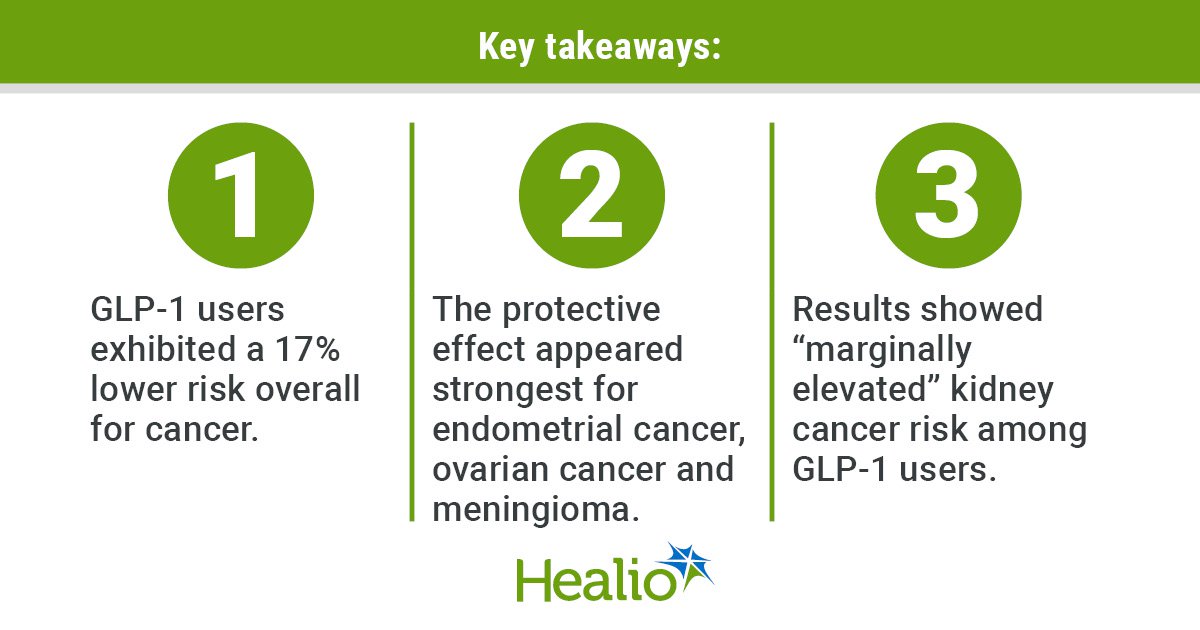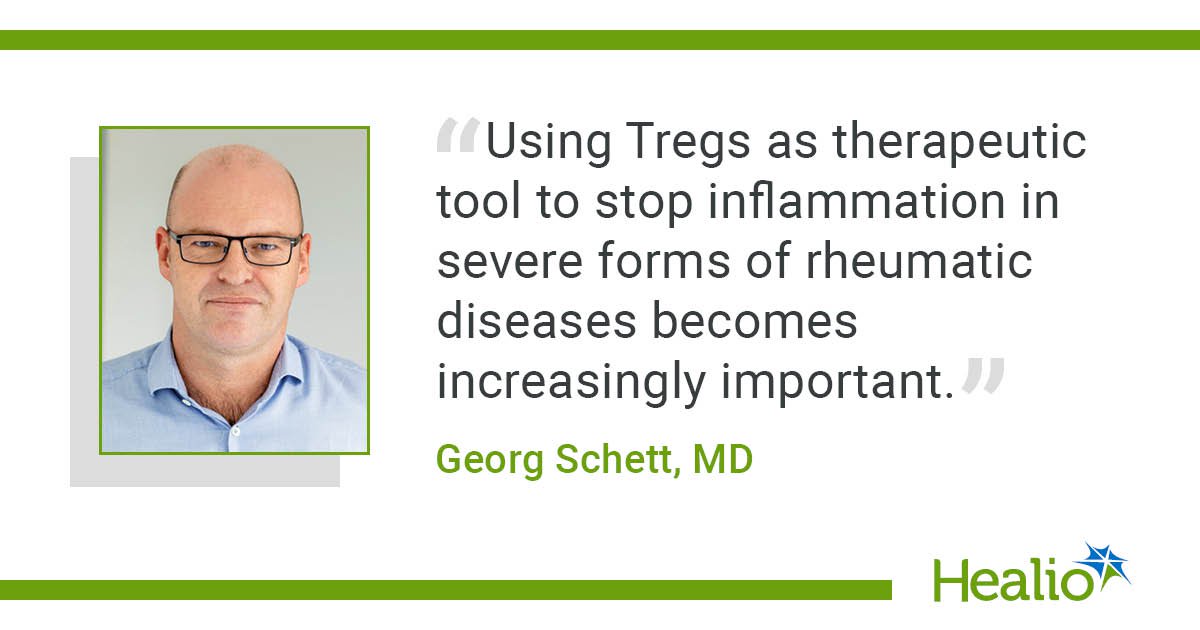August 21, 2025
4 min read
Key takeaways:
- Adults with obesity or overweight who used GLP-1 agents had lower overall cancer risk than nonusers.
- Results showed elevated kidney cancer risk among GLP-1 users but the difference did not reach statistical significance.
GLP-1 receptor agonists may reduce cancer risk among people with obesity or overweight, according to retrospective study results.
Adults who used GLP-1 medications exhibited a statistically significant reduction in risk for overall cancer. The protective effect appeared particularly strong for endometrial cancer, ovarian cancer and meningioma.

Data derived from Dai H, et al. JAMA Oncol. 2025;doi:10.1001/jamaoncol.2025.2681.
However, GLP-1 users exhibited a “marginally elevated” risk for kidney cancer, according to investigators.
“GLP-1 receptor agonists have a very good profile in terms of reducing excess weight and inflammation, both of which have established links to cancer,” Jiang Bian, PhD, MS, FACMI, associate dean for data science at Indiana University School of Medicine and chief data scientist for IU Health and Regenstrief Institute, told Healio. “There are some potential biases in these data that we need to be cautious about, but this gives us some valuable insights about the risk profile of these agents that can inform subsequent studies — perhaps even a randomized controlled trial — that can tease out the specific mechanisms and provide more conclusive evidence.”
Reduced risk overall
GLP-1 receptor agonists have been approved in the United States to treat diabetes since 2005 and obesity since 2014.
A KFF Health Tracking Poll released last year indicated about 12% of U.S. adults had used a GLP-1 agonist.
GLP-1 receptor agonists can reduce glucose, decrease inflammation and improve insulin resistance, three factors linked to cancer progression.
As Healio previously reported, a study by Bian and colleagues published earlier this year showed older adults with cancer and type 2 diabetes who used GLP-1 receptor agonists exhibited significantly lower risk for all-cause mortality than those treated with dipeptidyl peptidase-4 inhibitors.
However, the effects of GLP-1 agents and other glucose-lowering drugs on cancer risk are not well established.
Bian and colleagues aimed to evaluate this association in a retrospective cohort study that followed a target trial emulation design.
The researchers used electronic health record data from OneFlorida+ — a health research network that includes 10 health systems and clinical partners that serve nearly 20 million patients in Florida, Georgia and Alabama — to identify adults who were eligible for anti-obesity medications and had no cancer history.
The analysis included 86,632 adults (mean age, 52.4 years; 68.2% women; 44.2% non-Hispanic white) matched by propensity score based on GLP-1 receptor agonist users (n = 43,317) and nonusers (n = 43,315).
All adults had a recorded diagnosis of obesity — defined as BMI of 30 kg/m2 or higher — or BMI of 27 kg/m2 to 29.9 kg/m2 with at least one weight-related comorbidity. Nearly half (48.3%) of the cohort had obesity and 50.7% had type 2 diabetes.
The investigators compared incidence of 13 obesity-related cancers, as well as lung cancer, between these groups.
GLP-1 receptor agonist users exhibited lower risk for cancer overall than nonusers (incidence rate, 13.6 vs. 16.4 per 1,000 person-years; HR = 0.83; 95% CI, 0.76-0.91).
Researchers observed a statistically significant protective effect with GLP-1 use against three specific cancer types: endometrial cancer (HR = 0.75; 95% CI, 0.57-0.99), ovarian cancer (HR = 0.53; 95% CI, 0.29-0.96) and meningioma (HR = 0.69; 95% CI, 0.48-0.97).
Reductions in risk observed for several other cancer types — including upper gastrointestinal cancer (HR = 0.6; 95% CI, 0.29-1.24), lung cancer (HR = 0.76; 95% CI, 0.55-1.04) and thyroid cancer (HR = 0.77; 95% CI, 0.54-1.11) — did not reach statistical significance.
GLP-1 users exhibited a numerically higher risk for kidney cancer, but the difference did not reach statistical significance (HR = 1.38; 95% CI, 0.99-1.93).
Researchers identified several factors — including heart failure, type 2 diabetes, substance abuse, anticoagulant use and hypertension — that contributed to much of the individualized treatment effect for kidney cancer risk.
GLP-1 agents also have been shown in prior studies to improve kidney function. However, previous research has shown a statistically significant increase in kidney cancer risk with GLP-1 receptor agonists vs. metformin among people with type 2 diabetes.
“Potential benefits and harms must be balanced with any medical treatment,” Bian said. “The increased risk of kidney cancer that we observed was not statistically significant and I wouldn’t say it is alarming. However, it is consistent with other studies, so it warrants further study to better understand the biological mechanisms.”
Public health implications
The researchers acknowledged study limitations, including the potential for confounding in observational studies and the fact that several cancer types in the analysis had low event rates, leading to wide confidence intervals and limiting statistical power.
Also, because longitudinal BMI assessments were not included, it cannot be determined if the reductions in cancer risk observed were due to GLP-1 agents themselves or the weight loss the medications induced.
However, this study is one of the first to evaluate the association between GLP-1 receptor agonist use and cancer risk in a real-world population of adults with obesity or overweight.
“This class of medication has been available for a while, but these drugs really became popular in the past couple years because of their effects on weight management,” co-author Serena Jingchuan Guo, MD, PhD, associate professor and AI director at Purdue University College of Pharmacy, told Healio. “Because these are newer formulas and newer compounds, it definitely requires more accumulation of evidence from different populations with longer follow-up to reach definitive conclusions.”
The investigators plan to use Indiana’s statewide electronic health record database to further investigate the impact of GLP-1 agents on cancer risk.
Future research also could explore the effects of individual GLP-1 agents rather than the drug class as a whole.
“Because cancer is the second leading cause of death in the United States, these are very important questions and the answers they provide could have important public health implications,” Guo said.
For more information:
Jiang Bian, PhD, MS, FACMI, can be reached at bianji@iu.edu.
Serena Jingchuan Guo, MD, PhD, can be reached at guo959@purdue.edu.










